CHEVROLET S10 1993 2.G Owner's Manual
Manufacturer: CHEVROLET, Model Year: 1993, Model line: S10, Model: CHEVROLET S10 1993 2.GPages: 356, PDF Size: 20.85 MB
Page 21 of 356
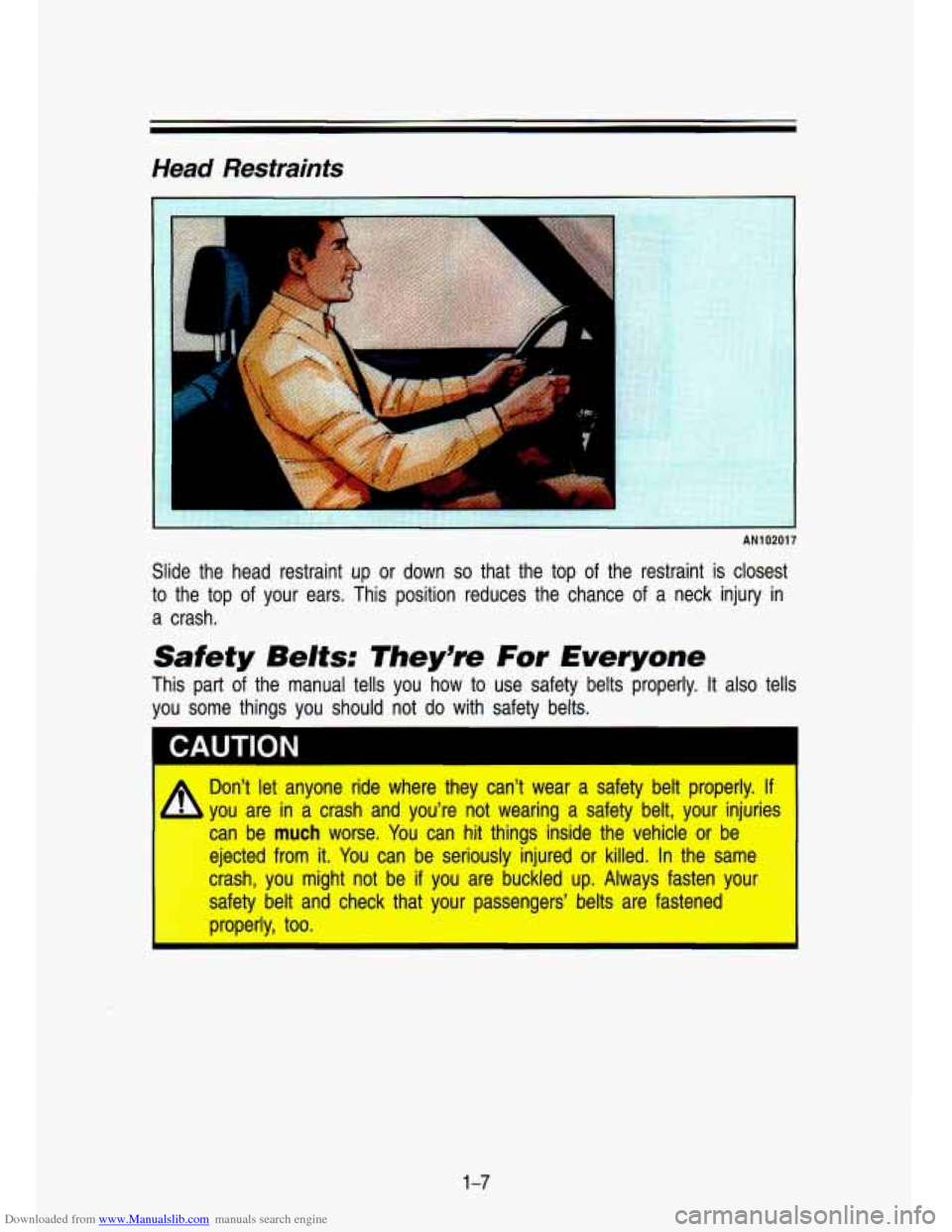
Downloaded from www.Manualslib.com manuals search engine Head Restraints
h
b
AN1 Oru I i
Slide the head restraint up or down so that the top of the restraint is closest
to the top of your ears. This position reduces the chance of a neck injury in
a crash.
Safety Belts: They9re For Everyone
This part of the manual tells you how to use safety belts properly. It also tells
you some things you should not
do with safety belts.
CAUTION
A
Don’t let anyone ride where they can’t wear a safety bel\
t properly. If
you are in a crash and you’re not wearing a safety belt, your injuries\
can be
much worse. You can hit things inside the vehicle or be
ejected from it. You can be seriously injured or killed. In the same
crash, you might not be
if you are buckled up. Always fasten your
safety belt and check that your passenaers’ belts are fasten\
ed properly, too.
1-7
Page 22 of 356
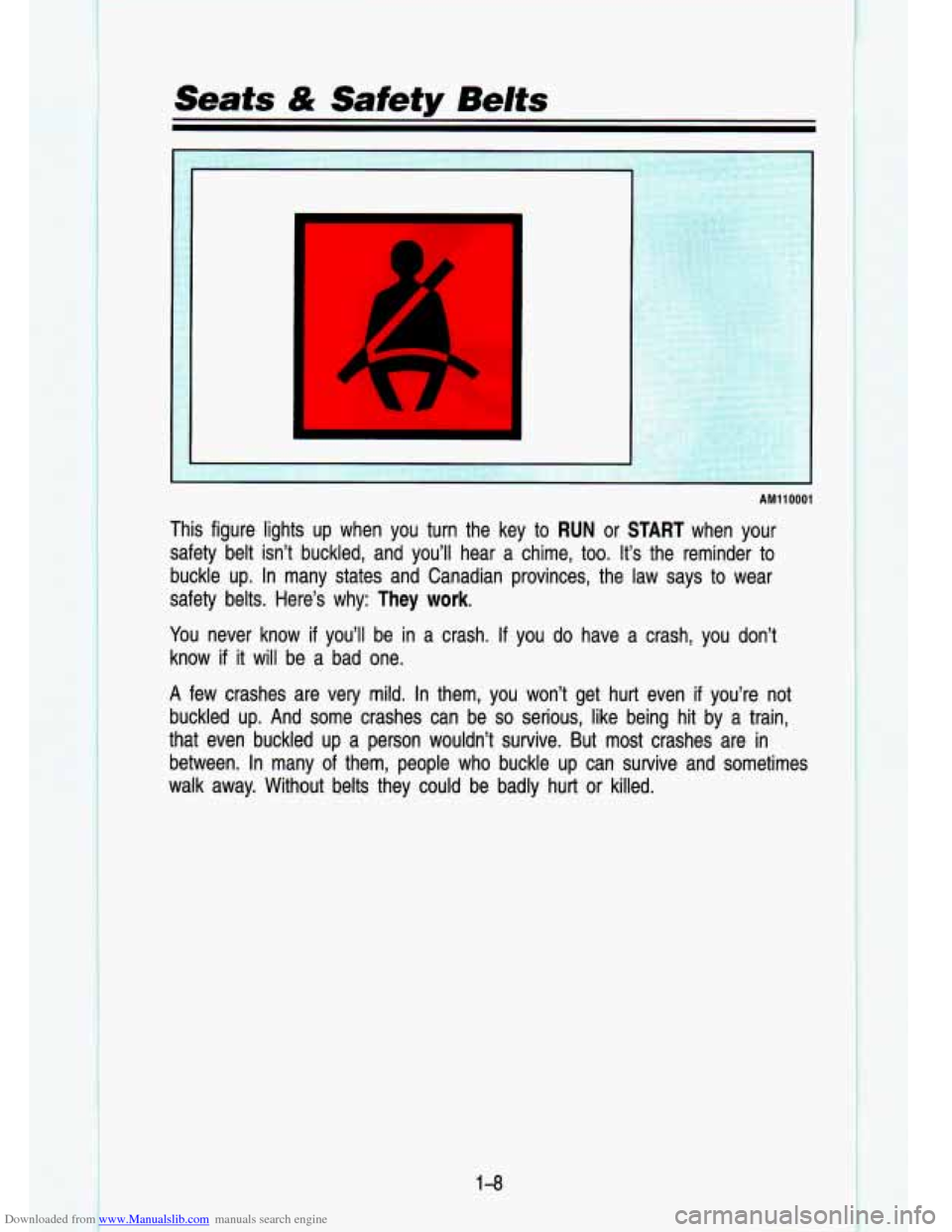
Downloaded from www.Manualslib.com manuals search engine Seats & Safety Belts
AM110001
This figure lights up when you turn the key to RUN or START when your
safety belt isn’t buckled, and you’ll hear a chime, too. \
It’s the reminder to
buckle up. In many states and Canadian provinces, the law says
to wear
safety belts. Here’s why:
They work.
You never know if you’ll be in a crash. If you do have a crash, you don’t
know
if it will be a bad one.
A few crashes are very mild. In them, you won’t get hurt even
if you’re not
buckled up. And some crashes can be
so serious, like being hit by a train,
that even buckled up a person wouldn’t survive. But most cr\
ashes are in
between. In many of them, people who buckle up can survive and sometimes
walk away. Without belts they could be badly hurt or killed.
1-8
I
Page 23 of 356
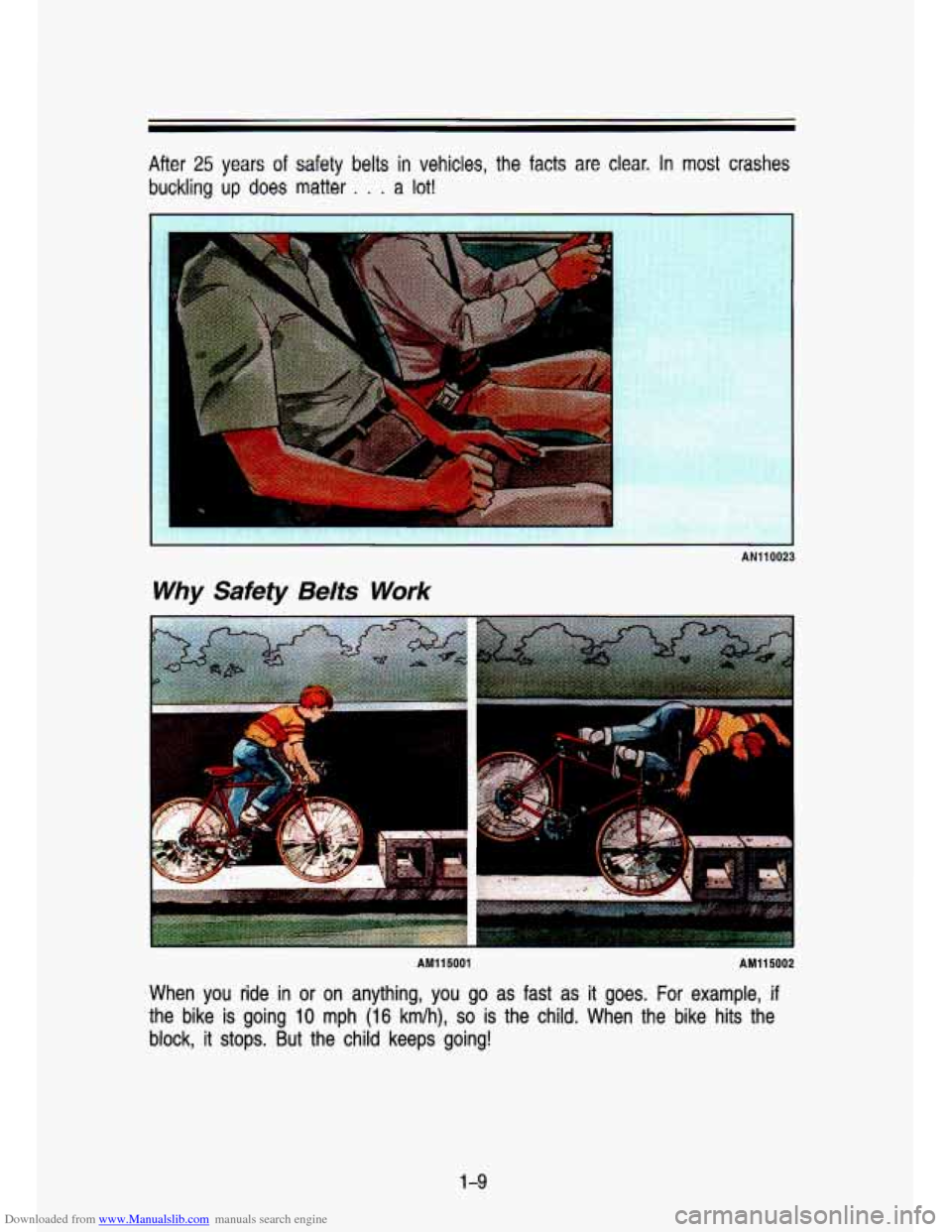
Downloaded from www.Manualslib.com manuals search engine After 25 years of safety belts in vehicles, the facts are clear. In most crashes
buckling up does matter . . . a lot!
AN110023
Why Safety Belts Work
AM115001 AM115002
When you ride in or on anything, you go as fast as it goes.\
For example, if
the bike
is going 10 mph (16 km/h), so is the child. When the bike hits the
block, it stops. But the child keeps going!
1-9
Page 24 of 356
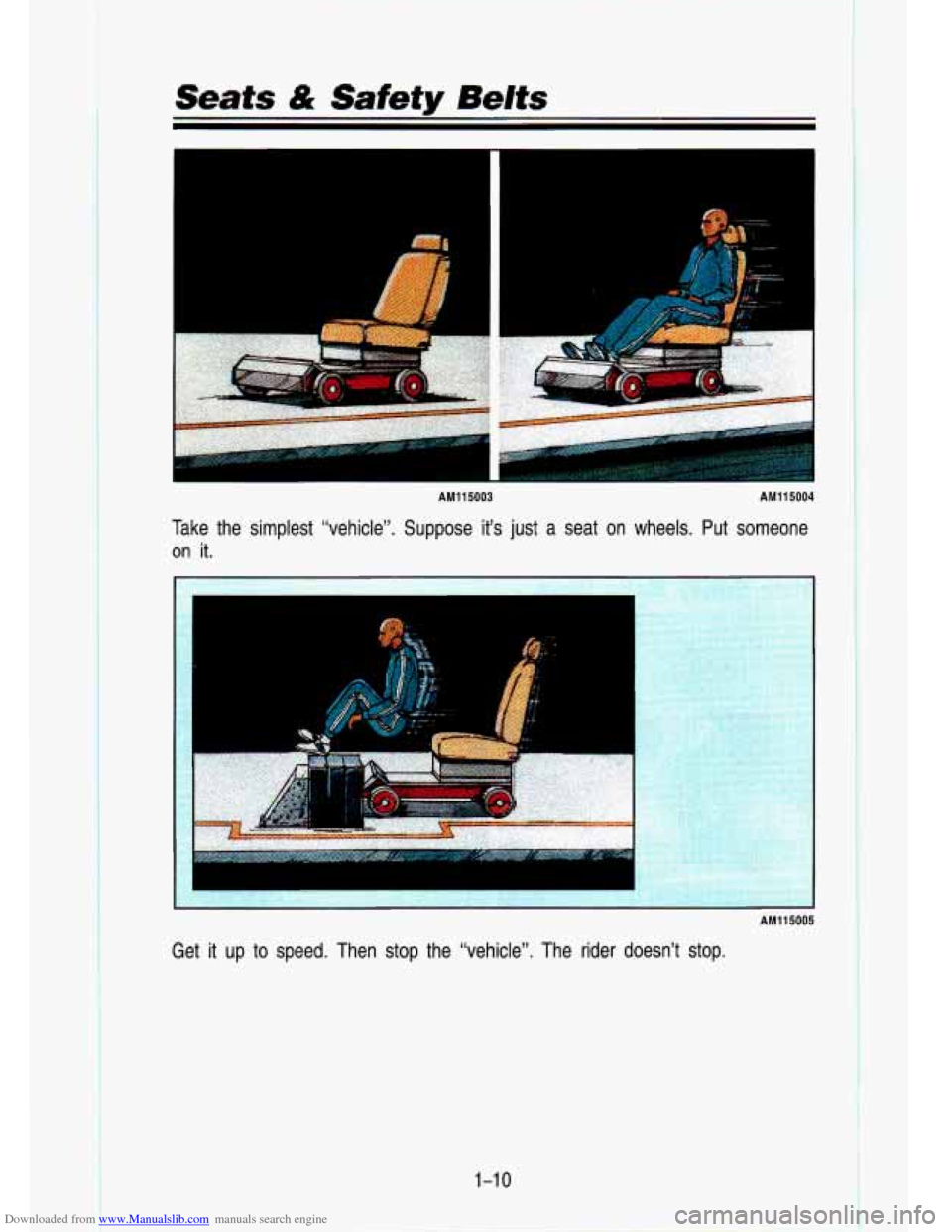
Downloaded from www.Manualslib.com manuals search engine Seats 4ik Safety Belts
AM11 5003 AM115004
Take the simplest “vehicle”. Suppose it’s just a seat on wh\
eels. Put someone
on
it.
.. A
AM115005
Get it up to speed. Then stop the “vehicle”. The rider doesn’\
t stop.
1-1 0
Page 25 of 356
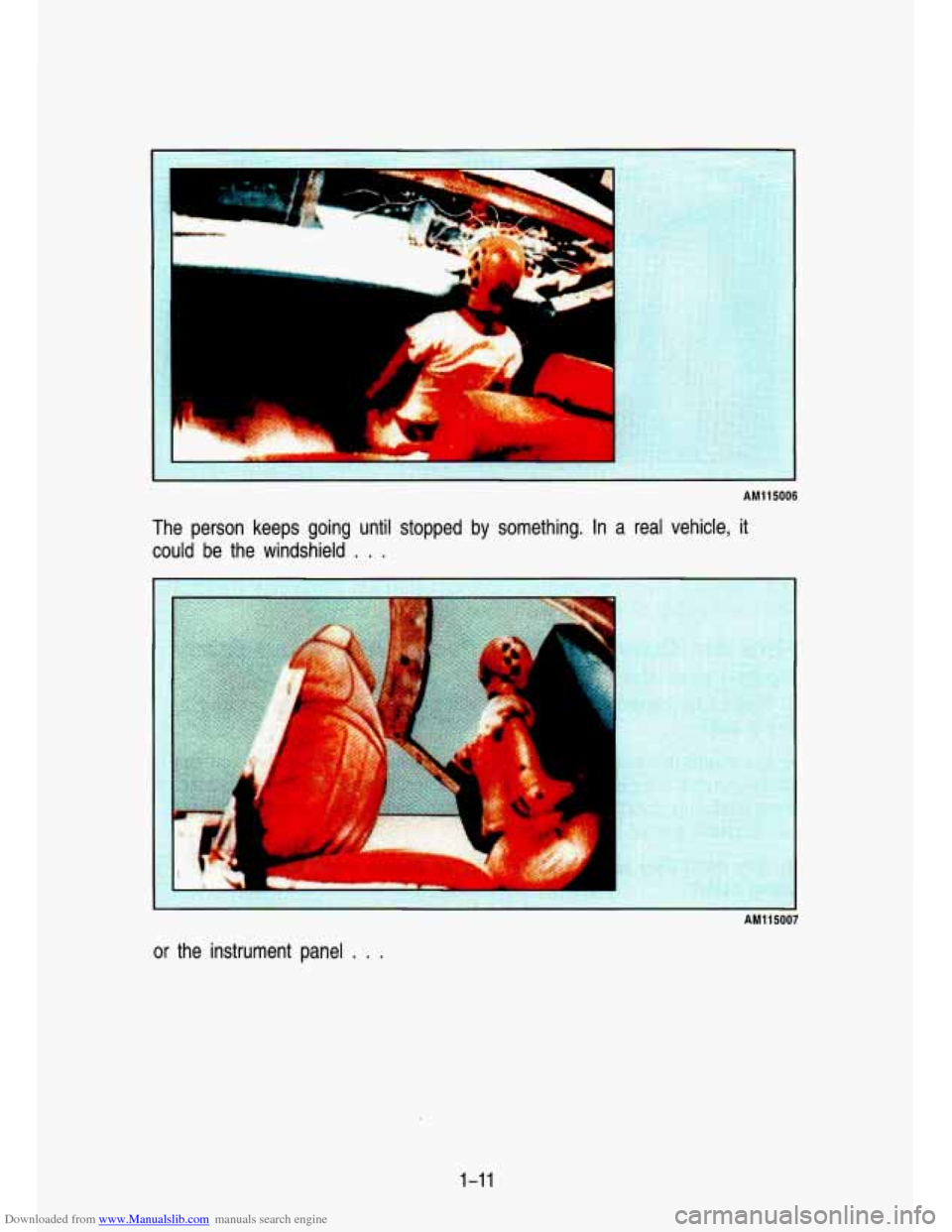
Downloaded from www.Manualslib.com manuals search engine .
AM115006
The person keeps going until stopped by something. In a real vehicle, it
could be the windshield
. . .
1-11
Page 26 of 356
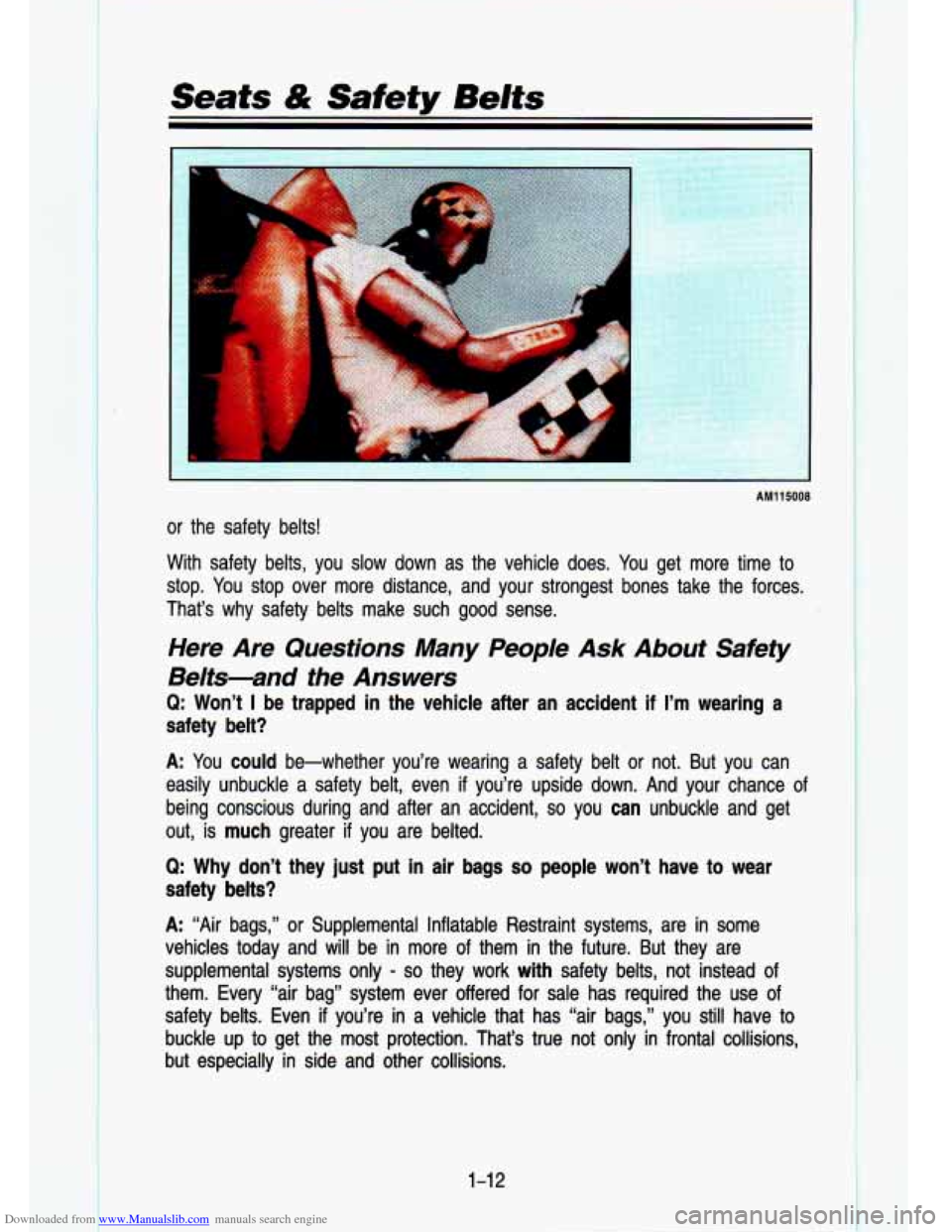
Downloaded from www.Manualslib.com manuals search engine Seats & Safety Belts
AM115008
or the safety belts!
With safety belts, you slow down as the vehicle does. You get more time to
stop. You stop over more distance, and your strongest bones take the for\
ces.
That‘s why safety belts make such good sense.
Here Are Questions Many People Ask About Safety
Belts-and the Answers
Q: Won’t I be trapped in the vehicle after an accident if I’m wearing a
safety belt?
A: You could be-whether you’re wearing a safety belt or not. But you can
easily unbuckle a safety belt, even
if you’re upside down. And your chance of
being conscious during and after an accident, so you can unbuckle and get
out, is much greater
if you are belted.
Q: Why don’t they just put in air bags so people won’t have to wear
safety belts?
A: “Air bags,” or Supplemental Inflatable Restraint systems, are in some
vehicles today and will be in more of them in the future. But they are
supplemental systems only
- so they work with safety belts, not instead of
them. Every “air bag” system ever offered for sale has r\
equired the use of
safety belts. Even if you’re in a vehicle that has “air bags,’’ you still have to
buckle up to get the most protection. That’s true not only
in frontal collisions,
but especially in side and other collisions.
1-1 2
Page 27 of 356
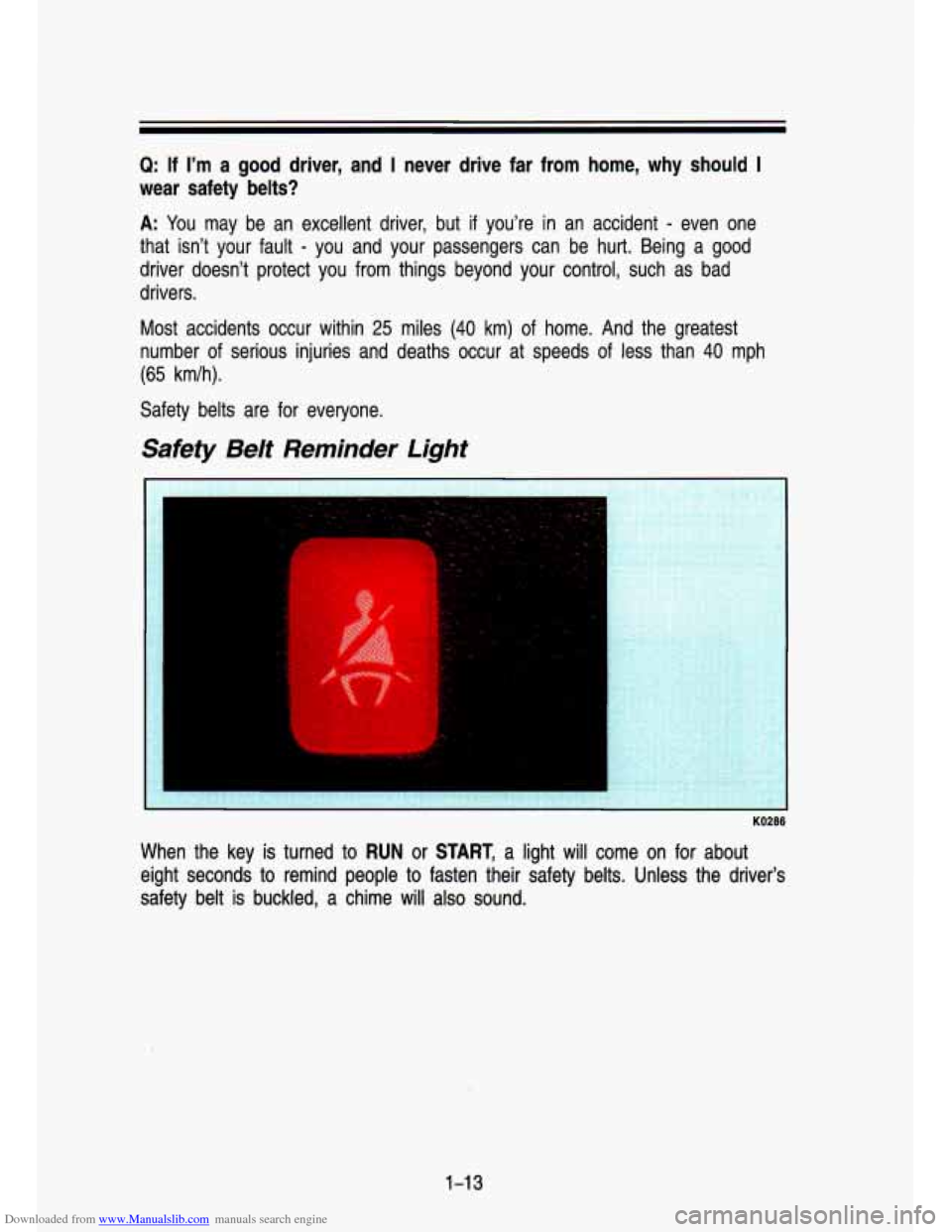
Downloaded from www.Manualslib.com manuals search engine Q: If I’m a good driver, and I never drive far from home, why should I
wear safety belts?
A: You may he an excellent driver, but if you’re in an accident - even one
that isn’t your fault
- you and your passengers can be hurt. Being a good
driver doesn’t protect you from things beyond your control, \
such as bad
drivers.
Most accidents occur within
25 miles (40 km) of home. And the greatest
number of serious injuries and deaths occur at speeds of less than
40 mph
(65 km/h).
Safety belts are for everyone.
Safety Belt Reminder Light
. .. .. -
KO286
When the key is turned to RUN or START, a light will come on for about
eight seconds to remind people to fasten their safety belts. Unless the driver’s
safety belt
is buckled, a chime will also sound.
1-1 3
Page 28 of 356
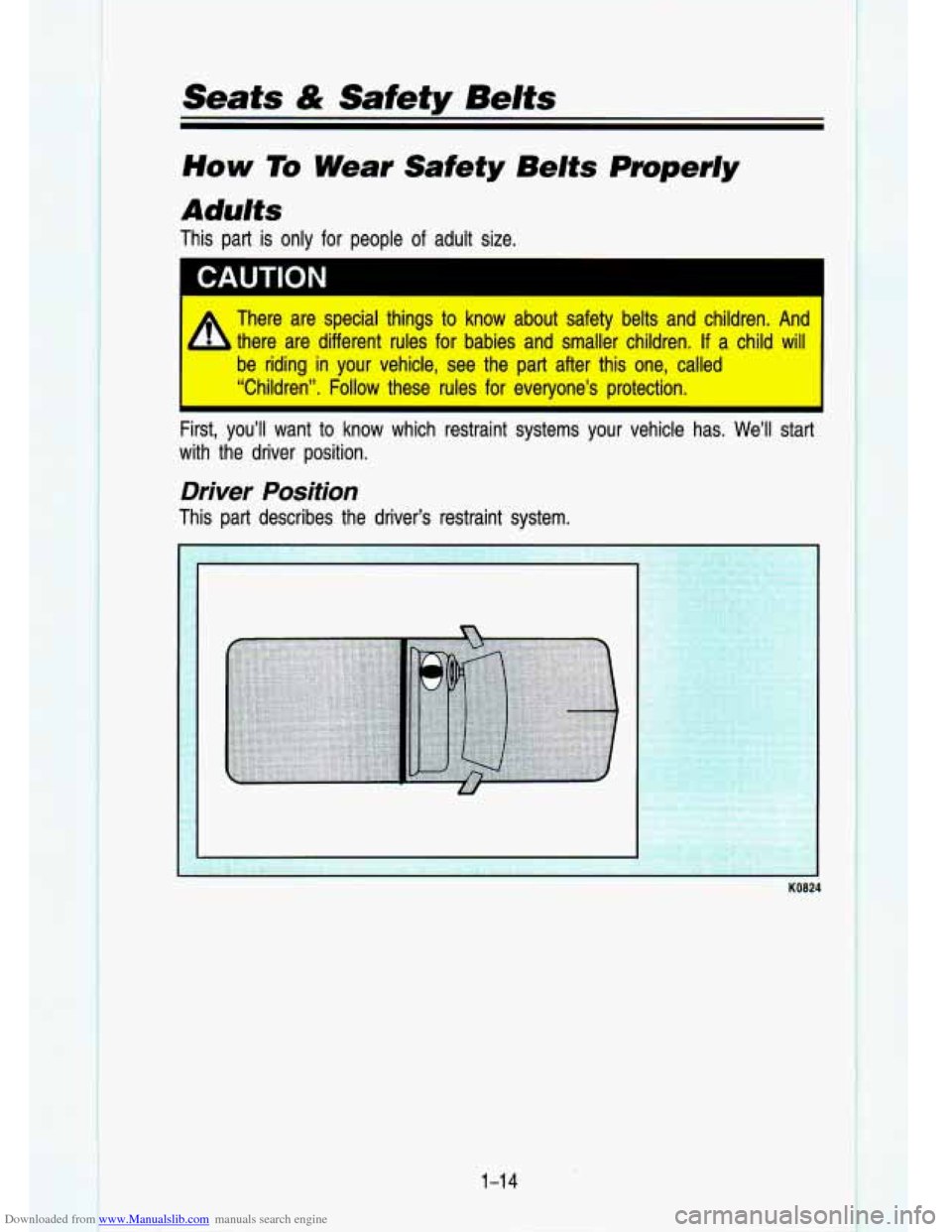
Downloaded from www.Manualslib.com manuals search engine Seats & Safety Belts
How To Wear Safety Belts Properly
Adults
This part is only for people of adult size.
There are special things to know about safety belts and children. And
L, there are different rules for babies and smaller children. If a child will
be riding in your vehicle, see the part after this one, calle\
d
“Children”. Follow these rules for everyone’s protection.\
First, you’ll want to know which restraint systems your vehicle has. We’ll start
with the driver position.
Driver Position
This part describes the driver’s restraint system.
KO824
1-14
Page 29 of 356
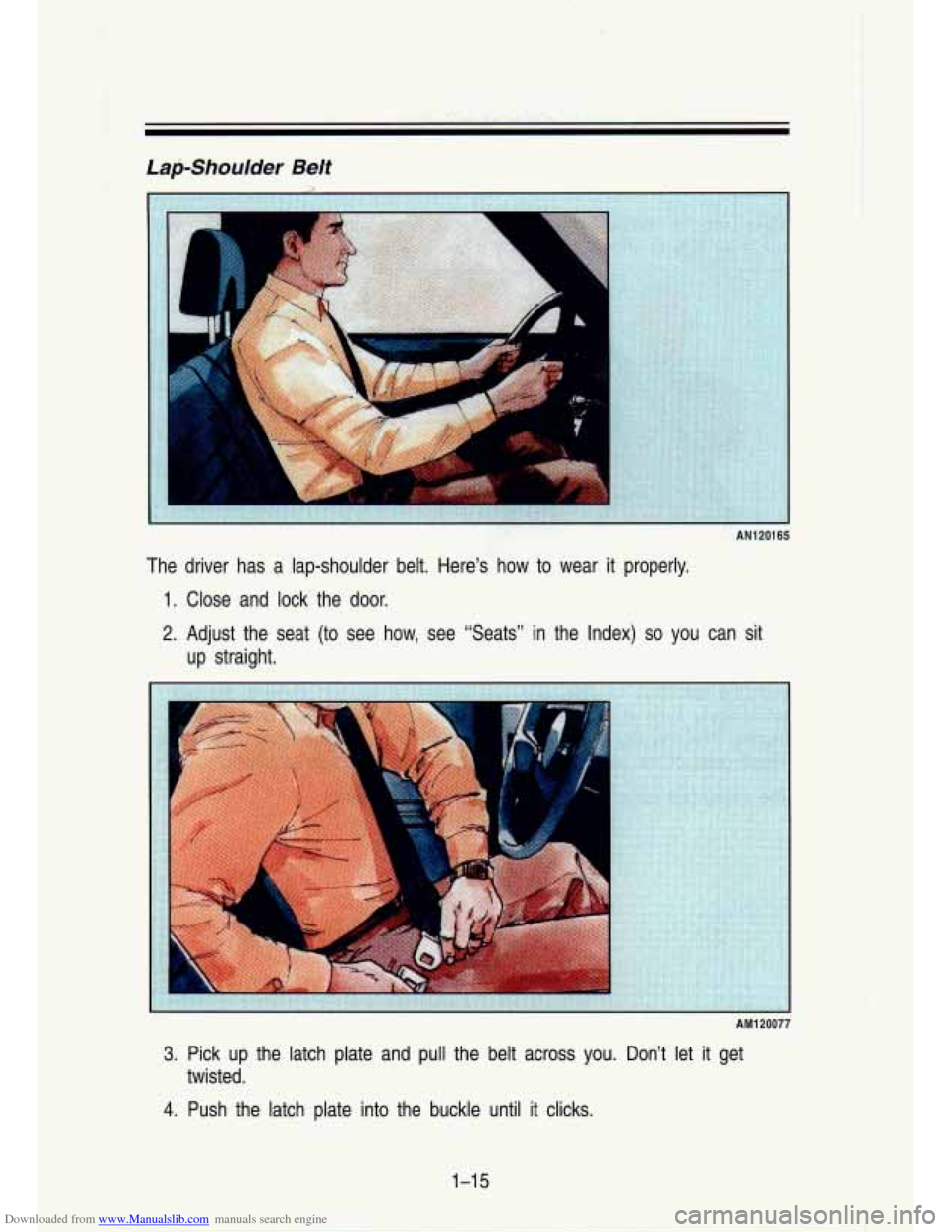
Downloaded from www.Manualslib.com manuals search engine Lap-Shoulder Belt
AN1 201 65
The driver has a lap-shoulder belt. Here’s how to wear it properly.
1. Close and lock the door.
2. Adjust the seat (to see how, see “Seats” in the Index) so you can sit
up straight.
AM120077
3. Pick up the latch plate and pull the belt across you. Don’t let it get
twisted.
4. Push the latch plate into the buckle until it clicks.
1-1 5
I
Page 30 of 356
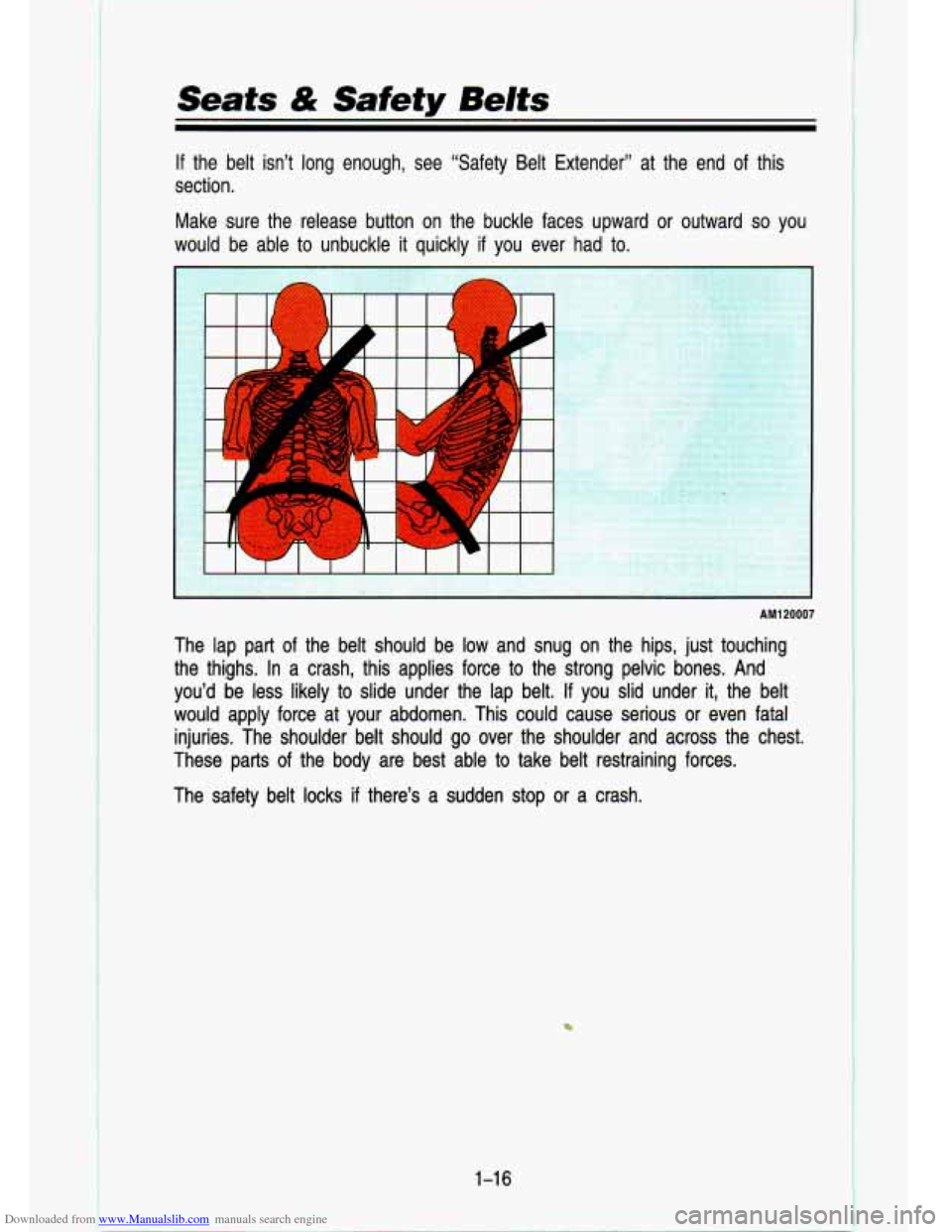
Downloaded from www.Manualslib.com manuals search engine Seats & Safety Belts
If the belt isn’t long enough, see “Safety Belt Extender” \
at the end of this
section.
Make sure the release button on the buckle faces upward or outward
so you
would be able to unbuckle it quickly
if you ever had to.
AM120007
The lap part of the belt should be low and snug on the hips, just touching
the thighs. In a crash, this applies force to the strong pelv\
ic bones. And
you’d be less likely to slide under the lap belt.
If you slid under it, the belt
would apply force at your abdomen. This could cause serious or\
even fatal
injuries. The shoulder belt should go over the shoulder and ac\
ross the chest.
These parts of the body are best able to take belt restraining forces.
The safety belt locks
if there’s a sudden stop or a crash.
. ,..
1-1 6